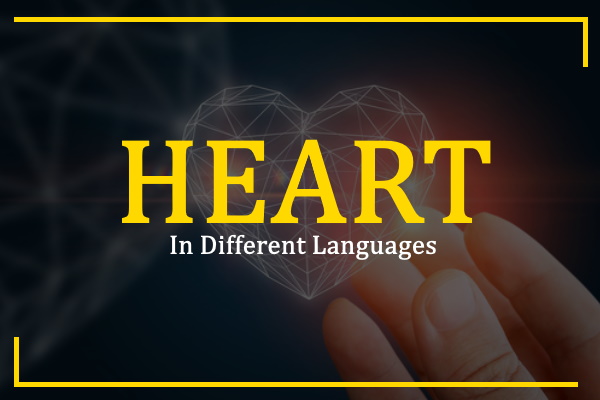Table of Contents
Heart in Different Languages: Heart is a muscular organ that pumps blood to circulate it in all parts of the body. Heart is located between lungs. The heart is split into four chambers of humans, other animals and birds: top left and right atria, bottom left and bottom right ventricles. In comparison, fish have two chambers, atrium and ventricle, while reptiles have three chambers. heart.
Heart in All Languages
Translation of word Heart in almost 100+ different languages of the world.
| Different Languages | Word Heart |
|---|---|
| Albanian | zemër |
| Basque | bihotz |
| Belarusian | сэрца |
| Bosnian | srce |
| Bulgarian | сърце |
| Catalan | cor |
| Croatian | srce |
| Czech | srdce |
| Danish | hjerte |
| Dutch | hart- |
| Estonian | süda |
| Finnish | sydän |
| French | cœur |
| Galician | corazón |
| German | Herz |
| Greek | καρδιά (kardiá) |
| Hungarian | szív |
| Icelandic | Hjarta |
| Irish | croí |
| Italian | cuore |
| Latvian | sirds |
| Lithuanian | širdis |
| Macedonian | срцето |
| Maltese | qalb |
| Norwegian | hjerte |
| Polish | serce |
| Portuguese | coração |
| Romanian | inimă |
| Russian | сердце (serdtse) |
| Serbian | срце (srce) |
| Slovak | Srdce |
| Slovenian | srce |
| Spanish | corazón |
| Swedish | hjärta |
| Ukrainian | серце (sertse) |
| Welsh | galon |
| Yiddish | האַרץ |
| Armenian | սիրտ |
| Azerbaijani | ürək |
| Bengali | হৃদয় |
| Chinese Simplified | 心 (xīn) |
| Chinese Traditional | 心 (xīn) |
| Georgian | გული |
| Gujarati | હૃદય |
| Hindi | दिल |
| Hmong | lub plawv |
| Japanese | ハート |
| Kannada | ಹೃದಯ |
| Kazakh | жүрек |
| Khmer | បេះដូង |
| Korean | 심장 (simjang) |
| Lao | ຫົວໃຈ |
| Malayalam | ഹൃദയം |
| Marathi | हृदय |
| Mongolian | зүрх |
| Myanmar (Burmese) | နှလုံး |
| Nepali | मुटु |
| Sinhala | හදවත |
| Tajik | дил |
| Tamil | இதயம் |
| Telugu | గుండె |
| Thai | หัวใจ |
| Turkish | kalp |
| Urdu | دل |
| Uzbek | yurak |
| Vietnamese | tim |
| Arabic | قلب (qalb) |
| Hebrew | לֵב |
| Persian | قلب |
| Afrikaans | hart |
| Chichewa | mtima |
| Hausa | zuciya |
| Igbo | obi |
| Sesotho | pelo |
| Somali | wadnaha |
| Swahili | moyo |
| Yoruba | okan |
| Zulu | inhliziyo |
| Cebuano | kasingkasing |
| Filipino | puso |
| Indonesian | jantung |
| Javanese | jantung |
| Malagasy | am-po |
| Malay | hati |
| Maori | ngakau |
| Esperanto | koro |
| Haitian Creole | kè |
| Latin | cor meum |
Heart in European Languages
Translation of word Heart in almost 42 European languages.
| Different Languages | Word Heart |
|---|---|
| Albanian | zemër |
| Basque | bihotz |
| Belarusian | сэрца |
| Bosnian | srce |
| Bulgarian | сърце |
| Catalan | cor |
| Corsican | core |
| Croatian | srce |
| Czech | srdce |
| Danish | hjerte |
| Dutch | hart- |
| Estonian | süda |
| Finnish | sydän |
| French | cœur |
| Frisian | hert |
| Galician | corazón |
| German | Herz |
| Greek | καρδιά [kardiá] |
| Hungarian | szív |
| Icelandic | Hjarta |
| Irish | croí |
| Italian | cuore |
| Latvian | sirds |
| Lithuanian | širdis |
| Luxembourgish | Häerz |
| Macedonian | срцето |
| Maltese | qalb |
| Norwegian | hjerte |
| Polish | serce |
| Portuguese | coração |
| Romanian | inimă |
| Russian | сердце [serdtse] |
| Scots Gaelic | cridhe |
| Serbian | срце [srce] |
| Slovak | Srdce |
| Slovenian | srce |
| Spanish | corazón |
| Swedish | hjärta |
| Tatar | йөрәк |
| Ukrainian | серце [sertse] |
| Welsh | galon |
| Yiddish | האַרץ |
Heart in Asian Languages
Translation of word Heart in almost 36 Asian languages.
| Different Languages | Word Heart |
|---|---|
| Armenian | սիրտ |
| Azerbaijani | ürək |
| Bengali | হৃদয় |
| Chinese Simplified | 心 [xīn] |
| Chinese Traditional | 心 [xīn] |
| Georgian | გული |
| Gujarati | હૃદય |
| Hindi | दिल |
| Hmong | lub plawv |
| Japanese | ハート |
| Kannada | ಹೃದಯ |
| Kazakh | жүрек |
| Khmer | បេះដូង |
| Korean | 심장 [simjang] |
| Kyrgyz | жүрөк |
| Lao | ຫົວໃຈ |
| Malayalam | ഹൃദയം |
| Marathi | हृदय |
| Mongolian | зүрх |
| Myanmar (Burmese) | နှလုံး |
| Nepali | मुटु |
| Odia | ହୃଦୟ |
| Pashto | هرات |
| Punjabi | ਦਿਲ |
| Sindhi | دل |
| Sinhala | හදවත |
| Tajik | дил |
| Tamil | இதயம் |
| Telugu | గుండె |
| Thai | หัวใจ |
| Turkish | kalp |
| Turkmen | ýürek |
| Urdu | دل |
| Uyghur | يۈرەك |
| Uzbek | yurak |
| Vietnamese | tim |
Heart in Middle East Languages
Translation of word Heart in 4 middle eastern languages.
| Different Languages | Word Heart |
|---|---|
| Arabic | قلب [qalb] |
| Hebrew | לֵב |
| Kurdish (Kurmanji) | dil |
| Persian | قلب |
Heart in African Languages
Translation of word Heart in almost 13 African languages.
| Different Languages | Word Heart |
|---|---|
| Afrikaans | hart |
| Amharic | ልብ |
| Chichewa | mtima |
| Hausa | zuciya |
| Igbo | obi |
| Kinyarwanda | umutima |
| Sesotho | pelo |
| Shona | mwoyo |
| Somali | wadnaha |
| Swahili | moyo |
| Xhosa | Intliziyo |
| Yoruba | okan |
| Zulu | inhliziyo |
Heart in Austronesian Languages
Translation of word Heart in almost 10 Austronesian languages.
| Different Languages | Word Heart |
|---|---|
| Cebuano | kasingkasing |
| Filipino | puso |
| Hawaiian | Puʻuwai |
| Indonesian | jantung |
| Javanese | jantung |
| Malagasy | am-po |
| Malay | hati |
| Maori | ngakau |
| Samoan | fatu |
| Sundanese | haté |
Heart in Other Foreign Languages
| Different Languages | Word Heart |
|---|---|
| Esperanto | koro |
| Haitian Creole | kè |
| Latin | cor meum |
Video Translation of Heart in 10 Other Languages
Coming Soon…
More Information about Heart
The right atrium and ventricle are usually called the right heart and their left counterparts are the left. The color of heart is light red.
Blood flows through the heart through a healthy heart due to cardiac valves that prevent the back flow.
A defensive membrane, the pericardium, often contains a small quantity of fluid is protecting the nucleus. The heart wall consists of three sections: epicardium myocardium and endocardium.
The heart is a little bigger than your fist and weighs between 7 and 15 ounces. The heart of a person can beat over 3.5 billion times by the end of a long life. In fact, the average heart pumps around 2,000 gallons of blood 100,000 times a day every day.
The world’s leading cause of death is medical disorders, including heart disease. The bulk of cardiovascular diseases are non-communicable and related to the diet and ageing.
Heart disease is a critical cause of death, averaging 30% of all deaths in 2008 worldwide. This rate in high-income countries varies from below 28% to high 40%.
Cardiologists are named doctors specializing in the heart. Many other people, including physicians, are engaged in the management of heart disease.
Blood provides all cells with oxygen and nutrients and extracts carbon dioxide and waste products from those cells.
Blood is transported through a complex artery, arterial, and capillary network from the heart to the rest of your body. Via venules and veins, blood is restored to your head.
If you stretch all your body vessels end to end on the surface of earth it would stretch for about 60,000 miles and can take a round of earth twice.

Arslan Hussain, founder of The Different Languages, is an experienced translator passionate about languages and cultures. Through his website, he shares his knowledge and love for different languages, making learning accessible and enjoyable.

